英文读写literature review范文
- 格式:doc
- 大小:45.50 KB
- 文档页数:3
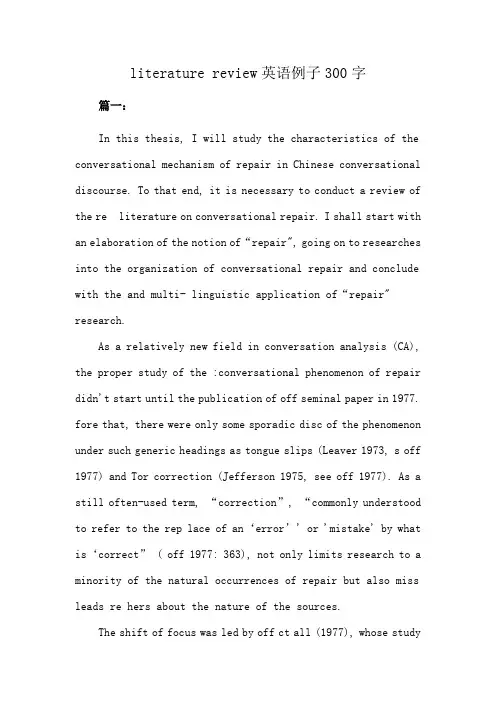
literature review英语例子300字篇一:In this thesis, I will study the characteristics of the conversational mechanism of repair in Chinese conversational discourse. To that end, it is necessary to conduct a review of the re literature on conversational repair. I shall start with an elaboration of the notion of“repair", going on to researches into the organization of conversational repair and conclude with the and multi- linguistic application of“repair" research.As a relatively new field in conversation analysis (CA), the proper study of the :conversational phenomenon of repair didn't start until the publication of off seminal paper in 1977. fore that, there were only some sporadic disc of the phenomenon under such generic headings as tongue slips (Leaver 1973, s off 1977) and Tor correction (Jefferson 1975, see off 1977). As a still often-used term, “correction”, “commonly understood to refer to the rep lace of an‘error’' or 'mistake' by what is‘correct” ( off 1977: 363), not only limits research to a minority of the natural occurrences of repair but also miss leads re hers about the nature of the sources.The shift of focus was led by off ct all (1977), whose studywas an based effort to examine the organization of repair as a set of ordered, but not equals.The phenomenon of correction was there fore proven part of a much wider picture, i.e. repair and the scope of discussion was greatly expanded fromthe mere correcting of some“ [usually linguistic] errors”(1977: 363) to all poss “practices for dealing with problems or troubles in speaking, hearing, and understanding the talk in conversation”(2000: 207), a definition given by off himself some 20 years later. In deed, potential in conversation inc not only correction of information, but also and more importantly rep of inappropriate items or ambiguous , word search and clarification of .篇二:Many studies have been carried out with regard to the various dimensions of conversational repair itself, e.g. its class , sites, forms and causes.l (1977) classified four types of repair according to the subject(s) of initiation/repair, namely other- initiated other repair.This c lass has been adopted by many researchers later, making it easier to tack conversational data. Yet (1994: 56) suggests, rightly I think, that this classification is in needof refinement as it is not always to draw a sharp boundary between self and other initiation. He found a sort ofother-prompted initiation, which underlines the interactive aspect of conversational discourse.Along with the four-type classification.。
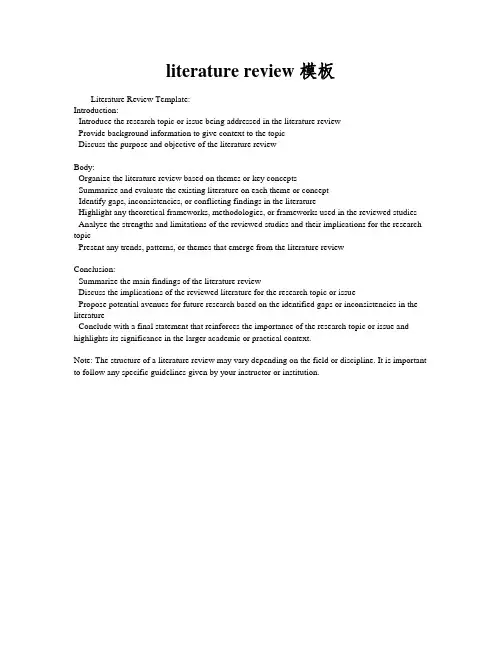
literature review 模板Literature Review Template:Introduction:- Introduce the research topic or issue being addressed in the literature review- Provide background information to give context to the topic- Discuss the purpose and objective of the literature reviewBody:- Organize the literature review based on themes or key concepts- Summarize and evaluate the existing literature on each theme or concept- Identify gaps, inconsistencies, or conflicting findings in the literature- Highlight any theoretical frameworks, methodologies, or frameworks used in the reviewed studies - Analyze the strengths and limitations of the reviewed studies and their implications for the research topic- Present any trends, patterns, or themes that emerge from the literature reviewConclusion:- Summarize the main findings of the literature review- Discuss the implications of the reviewed literature for the research topic or issue- Propose potential avenues for future research based on the identified gaps or inconsistencies in the literature- Conclude with a final statement that reinforces the importance of the research topic or issue and highlights its significance in the larger academic or practical context.Note: The structure of a literature review may vary depending on the field or discipline. It is important to follow any specific guidelines given by your instructor or institution.。
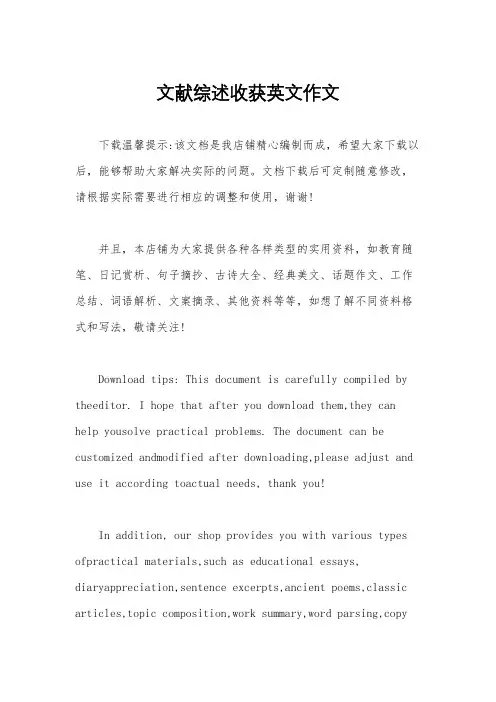
文献综述收获英文作文下载温馨提示:该文档是我店铺精心编制而成,希望大家下载以后,能够帮助大家解决实际的问题。
文档下载后可定制随意修改,请根据实际需要进行相应的调整和使用,谢谢!并且,本店铺为大家提供各种各样类型的实用资料,如教育随笔、日记赏析、句子摘抄、古诗大全、经典美文、话题作文、工作总结、词语解析、文案摘录、其他资料等等,如想了解不同资料格式和写法,敬请关注!Download tips: This document is carefully compiled by theeditor. I hope that after you download them,they can help yousolve practical problems. The document can be customized andmodified after downloading,please adjust and use it according toactual needs, thank you!In addition, our shop provides you with various types ofpractical materials,such as educational essays, diaryappreciation,sentence excerpts,ancient poems,classic articles,topic composition,work summary,word parsing,copyexcerpts,other materials and so on,want to know different data formats andwriting methods,please pay attention!I learned a lot from doing the literature review. It made me realize how much knowledge there is out there. I found so many different ideas and perspectives. It was like opening a door to a whole new world.Doing the literature review also helped me improve my research skills. I had to search for relevant materials and analyze them carefully. It taught me how to be more organized and critical.Another thing I gained was a better understanding of the topic. I got to see what others have done and said before. It gave me a broader view and helped me form my own opinions.I also discovered that there are always gaps in the existing research. This made me think about how I could contribute something new. It inspired me to explore further and come up with my own ideas.。
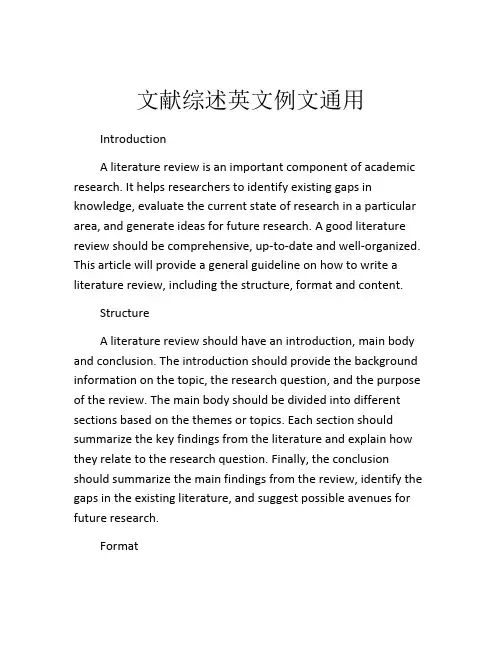
文献综述英文例文通用IntroductionA literature review is an important component of academic research. It helps researchers to identify existing gaps in knowledge, evaluate the current state of research in a particular area, and generate ideas for future research. A good literature review should be comprehensive, up-to-date and well-organized. This article will provide a general guideline on how to write a literature review, including the structure, format and content.StructureA literature review should have an introduction, main body and conclusion. The introduction should provide the background information on the topic, the research question, and the purpose of the review. The main body should be divided into different sections based on the themes or topics. Each section should summarize the key findings from the literature and explain how they relate to the research question. Finally, the conclusion should summarize the main findings from the review, identify the gaps in the existing literature, and suggest possible avenues for future research.FormatA literature review can be written in different formats depending on the discipline and the research topic. In general, there are two common formats: the narrative review and the systematic review. The narrative review is a descriptive summary of the literature, whereas the systematic review is a more rigorous evaluation of the literature using a predefined search strategy and inclusion/exclusion criteria.ContentThe content of a literature review should be focused on the research question and the themes identified in the main body. The literature reviewed should be relevant, reliable, and recent. The sources of the literature can be primary or secondary, depending on the research question and the availability of the literature. The sources can be in different forms, such as articles, books, reports, conference proceedings, and online databases.TipsHere are some tips on how to write a good literature review:- Start early: Begin the literature review as early as possible to allow sufficient time for reading, writing, and revising.- Define the research question: Clearly define the research question to guide the literature search and the selection of the literature.- Use appropriate keywords: Use appropriate keywords and search terms to identify the relevant literature.- Keep records: Keep a record of the literature searched, read and cited to avoidduplication and facilitate referencing.- Analyze and synthesize: Analyze the literature critically and synthesize the findings into a coherent and organized structure.- Avoid plagiarism: Acknowledge the sources of the literature accurately and avoid plagiarism by paraphrasing and referencing properly.- Be critical: Be critical of the literature reviewed and identify the strengths, weaknesses, and limitations of the research in the field.ConclusionIn summary, a literature review is an essential component of academic research, and it requires careful planning, organizing, and writing. A good literature review should provide a comprehensive and critical evaluation of the existing literature and identify the gaps and limitations in the research field. By following the guidelines and tips provided in this article, researchers can write a well-structured, informative and engaging literature review.。
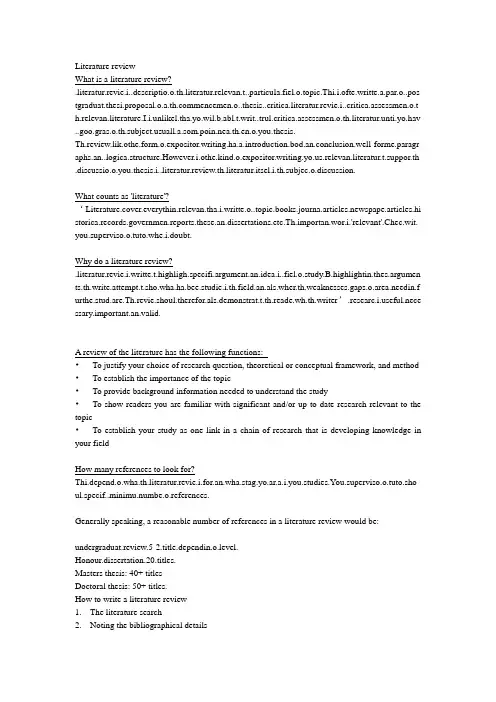
Literature reviewWhat is a literature review?.literatur.revie.i..descriptio.o.th.literatur.relevan.t..particula.fiel.o.topic.Thi.i.ofte.writte.a.par.o..pos mencemen.o..thesis..critica.literatur.revie.i..critica.assessmen.o.t h.relevan.literature.I.i.unlikel.tha.yo.wil.b.abl.t.writ..trul.critica.assessmen.o.th.literatur.unti.yo.hav uall.a.som.poin.nea.th.en.o.you.thesis.Th.review.lik.othe.form.o.expositor.writing.ha.a.introduction.bod.an.conclusion.well-forme.paragr .relevan.literatur.t.suppor.th .discussio.o.you.thesis.i..literatur.review.th.literatur.itsel.i.th.subjec.o.discussion.What counts as 'literature'?‘Literature.cover.everythin.relevan.tha.i.writte.o..topic.books.journa.articles.newspape.articles.hi ernmen.reports.these.an.dissertations.etc.Th.importan.wor.i.'relevant'.Chec.wit. you.superviso.o.tuto.whe.i.doubt.Why do a literature review?.literatur.revie.i.writte.t.highligh.specifi.argument.an.idea.i..fiel.o.study.B.highlightin.thes.argumen ts.th.write.attempt.t.sho.wha.ha.bee.studie.i.th.field.an.als.wher.th.weaknesses.gaps.o.area.needin.f urthe.stud.are.Th.revie.shoul.therefor.als.demonstrat.t.th.reade.wh.th.writer’eful.nece ssary.important.an.valid.A review of the literature has the following functions:•To justify your choice of research question, theoretical or conceptual framework, and method •To establish the importance of the topic•To provide background information needed to understand the study•To show readers you are familiar with significant and/or up-to-date research relevant to the topic•To establish your study as one link in a chain of research that is developing knowledge in your fieldHow many references to look for?Thi.depend.o.wha.th.literatur.revie.i.for.an.wha.stag.yo.ar.a.i.you.studies.You.superviso.o.tuto.sho ul.specif..minimu.numbe.o.references.Generally speaking, a reasonable number of references in a literature review would be:undergraduat.review.5-2.title.dependin.o.level.Honour.dissertation.20.titles.Masters thesis: 40+ titlesDoctoral thesis: 50+ titles.How to write a literature review1.The literature search2.Noting the bibliographical details3.Finding the literature4.Reading the literatureTak.note.a.yo.rea.th.literature.Yo.ar.readin.t.fin.ou.ho.eac.piec.o.writin.approache.th.subjec.o.you.r esearch.wha.i.ha.t.sa.abou.it.an.(especiall.fo.researc.students.ho.i.relate.t.you.ow.thesis:Is it a general textbook or does it deal with a specific issue(s)?Is it an empirical report, a theoretical study, a sociological or political account, a historical overview, etc? All or some of these?Does it follow a particular school of thought?What is its theoretical basis?What definitions does it use?What is its general methodological approach? What methods are used?What kinds of data does it use to back up its argument?What conclusions does it come to?5.Writin.th.reviewHavin.gathere.th.relevan.detail.abou.th.literature.yo.no.nee.t.writ.th.review.Th.kin.o.revie.yo.write .an.th.amoun.o.detail.wil.depen.o.th.leve.o.you.studies.Note 1: do not confuse a literature review with an annotated bibliography.An annotated bibliography deals with each text in turn, describing and evaluating the text, using one paragraph for each text.I.contrast..literatur.revie.group.relate.work.togethe.an.discusse.trend.an.development.rathe.tha.foc usin.o.on.ite.a..time.I.i.no..summary.rather.i.evaluate.previou.an.curren.researc.i.regar.t.ho.relevan. and/efu.i.i.an.ho.i.relate.t.you.ow.research.A Literature Review is more than an Annotated Bibliography or a summary, because you are organizing and presenting your sources in terms of their overall relationship to your own project.Note 2: think of the review as a funnelTh.revie.mus.b.shape.b..focu.o.ke.area.o.interest.includin.researc.whic.provide..backgroun.t.th.top i.(dependin.o.whethe.i.i.fo.a.Honour.thesi.o.fo..PhD)mo.mistak.i.writin efu.t.thin.o.th. revie.a..funne..star.wid.wit.th.overvie.an.the.quickl.narro.int.discussin.th.researc.tha.relate.t.you.sp ecifi.topic.•Anothe.wa.o.lookin.a.th.process.particularl.i.yo.ar.examinin.severa.topic.(o.variables).i.t.thin. o.yoursel.a..fil.directo.(Rudesta.an.Newton.1992).Yo.ca.thin.o.providin.you.audienc.with.•long shots to provide a solid sense of the background•middle distance shots where the key figures and elements to be examined are brought clearly into view•close-up shots where the precise focus of your work is pinpointedSections of literature reviewLik.al.academi.writing..literatur.revie.i.writte.i.essa.format.I.mus.hav.a.introduction.body.an.concl usion.The introduction should include:1)the nature of the topic under discussion (the topic of your thesis)2)the parameters of the topic (what does it include and exclude)?3)the basis for your selection of the literatureThe conclusion should include:1)A summary of major agreements and disagreements in the literature2).summar.o.genera.conclusion.tha.ar.bein.drawn.3)A summary of where your thesis sits in the literatureThe body paragraphs could include relevant paragraphs on:1)historical background, including classic texts;2)current mainstream versus alternative theoretical or ideological viewpoints, including differing theoretical assumptions, differing political outlooks, and other conflicts;3)possible approaches to the subject (empirical, philosophical, historical, postmodernist, etc);4)definitions in use;5)current research studies;6)current discoveries about the topic;7)principal questions that are being asked;8)general conclusions that are being drawn;9)methodologies and methods in use;Structure of literature reviewmo.way.ar.chronologicall.an.them atically.Chronological.grou.an.discus.you.source.i.orde.o.thei.appearanc.(usuall.publication).highlightin.th.change.i.researc.i.th.fiel.an.you.specifi.topi.ove.time.e.g.metaphor—ho.th.definitio.o.i.change.throug.tim.b.givin.som.example.o.ke.concept.mad.b.scholars.an .i.you.thesis2)Thematic.grou.an.discus.you.source.i.term.o.th.theme.o.topic.the.cover.Thi.metho.i.ofte..stronge.on.organizationally.an.i.ca.hel.yo.resis.th.urg.t.summariz.you.sources.B.groupin.theme.o.topic.o.researc.together.yo.wil.b.abl.t.demonstrat.th.type.o.topic.tha.ar.importan.t.you.research.e.g.stud.o.Feminis.i.Jan.Eyre—commnet.o.Charlott.Brontecomments on Jane Eyrecomments on Feminism※No matter which method you choose, remember:Withi.eac.sectio.o..literatur.review.i.i.importan.t.discus.ho.th.researc.relate.t.othe.studie.(ho.i.i.simila.o.different.wha.othe.studie.hav.bee.done.etc..a.wel.a.t.demonstrat.ho.i.relate.t.you.ow.work.Thi.i .wha.th.revie.i.for.don’.leav.thi.connectio.out.Criteria of good literature reviewA review of the literature should:•Set up a theoretical framework for your research•Show your reader that you have a clear understanding of the key concepts/ideas/studies/ models related to your topic•know about the history of your research area and any related controversies•can discuss these ideas in a context appropriate for your own investigation•can evaluate the work of others•Clarify important definitions/terminology•Develop the research space you will also indicate in the Introduction and Abstract•Narrow the problem; make the study feasibleQuestions you need to ask yourself when you are planning and drafting your Literature Review: •What has been done in your field of research? What principles of selection are you going to use?•How are you going to order your discussion? Chronological, thematic, conceptual, methodological, or a combination? What section headings will you use?•How do the various studies relate to each other? What precise contribution do they make to the field? What are their limitations or are there any gaps? Are there new ways of looking at the topic?•What future directions should research in this subject take?•How does your own research fit into what has already been done? What contribution will your research make to the field?Sample Analysis。
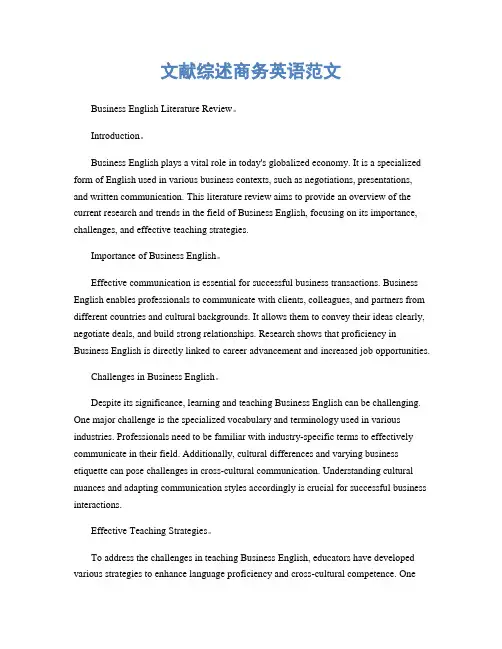
文献综述商务英语范文Business English Literature Review。
Introduction。
Business English plays a vital role in today's globalized economy. It is a specialized form of English used in various business contexts, such as negotiations, presentations, and written communication. This literature review aims to provide an overview of the current research and trends in the field of Business English, focusing on its importance, challenges, and effective teaching strategies.Importance of Business English。
Effective communication is essential for successful business transactions. Business English enables professionals to communicate with clients, colleagues, and partners from different countries and cultural backgrounds. It allows them to convey their ideas clearly, negotiate deals, and build strong relationships. Research shows that proficiency in Business English is directly linked to career advancement and increased job opportunities.Challenges in Business English。
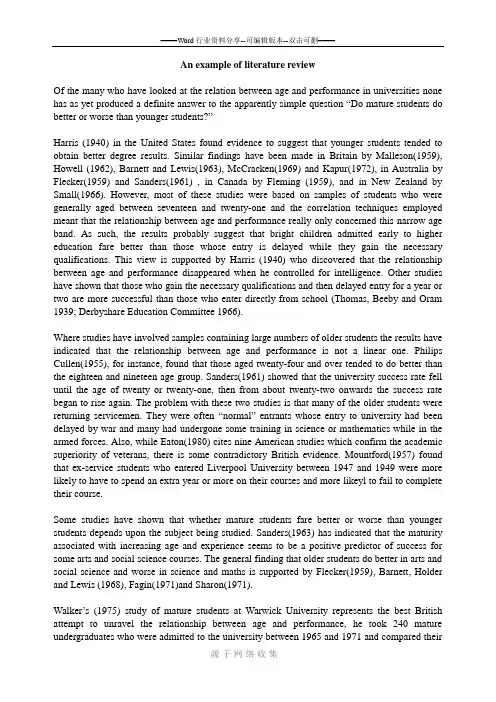
An example of literature reviewOf the many who have looked at the relation between age and performance in universities none has as yet produced a definite answer to the apparently simple question “Do mature students do better or worse than younger students?”Harris (1940) in the United States found evidence to suggest that younger students tended to obtain better degree results. Similar findings have been made in Britain by Malleson(1959), Howell (1962), Barnett and Lewis(1963), McCracken(1969) and Kapur(1972), in Australia by Flecker(1959) and Sanders(1961) , in Canada by Fleming (1959), and in New Zealand by Small(1966). However, most of these studies were based on samples of students who were generally aged between seventeen and twenty-one and the correlation techniques employed meant that the relationship between age and performance really only concerned this narrow age band. As such, the results probably suggest that bright children admitted early to higher education fare better than those whose entry is delayed while they gain the necessary qualifications. This view is supported by Harris (1940) who discovered that the relationship between age and performance disappeared when he controlled for intelligence. Other studies have shown that those who gain the necessary qualifications and then delayed entry for a year or two are more successful than those who enter directly from school (Thomas, Beeby and Oram 1939; Derbyshare Education Committee 1966).Where studies have involved samples containing large numbers of older students the results have indicated that the relationship between age and performance is not a linear one. Philips Cullen(1955), for instance, found that those aged twenty-four and over tended to do better than the eighteen and nineteen age group. Sanders(1961) showed that the university success rate fell until the age of twenty or twenty-one, then from about twenty-two onwards the success rate began to rise again. The problem with these two studies is that many of the older students were returning servicemen. They were often “normal”entrants whose entry to university had been delayed by war and many had undergone some training in science or mathematics while in the armed forces. Also, while Eaton(1980) cites nine American studies which confirm the academic superiority of veterans, there is some contradictory British evidence. Mountford(1957) found that ex-service students who entered Liverpool University between 1947 and 1949 were more likely to have to spend an extra year or more on their courses and more likeyl to fail to complete their course.Some studies have shown that whether mature students fare better or worse than younger students depends upon the subject being studied. Sanders(1963) has indicated that the maturity associated with increasing age and experience seems to be a positive predictor of success for some arts and social science courses. The general finding that older students do better in arts and social science and worse in science and maths is supported by Flecker(1959), Barnett, Holder and Lewis (1968), Fagin(1971)and Sharon(1971).Walker’s (1975) study of mature students at Warwick University represents the best British attempt to unravel the relationship between age and performance, he took 240 mature undergraduates who were admitted to the university between 1965 and 1971 and compared theirprogress with that of all undergraduates. This gave him a reasonably large sample to work with and the timing meant that the results were not distorted by any “returning servicemen factor”. His methodology showed many other refinements. First, he excluded overseas students. Such students tend to be older than average and also to fare worse academically (Woodley 1979), thus influencing any age/performance relationship. Secondly, he used two measures of performance; the proportion of those leaving without obtaining a degree and the degree results of those taking final examinations. Finally, he weighted the degree class obtained according to its rarity value in each faculty.The following findings achieved statistical significance:(i) In total, mature students obtained better degrees than non-mature students.(ii) In the arts faculty mature students obtained better degrees than non-mature students.(iii) Mature students who did not satisfy the general entrance requirements obtained better degrees than all other students.(iv) The degree results of mature students age twenty-six to thirty were better than those of all other mature students.Several other differences were noted but they did not achieve statistical significance due to the small numbers involved. The mature student sample only contained thirty-tree women, twenty-six science students and thirty-seven aged over thirty. The aim of the present study was to extend Walker’s work to all British universities so that these and other relationships could be tested out on a much larger sample of mature students.(Woodley, 1985:152-4)。
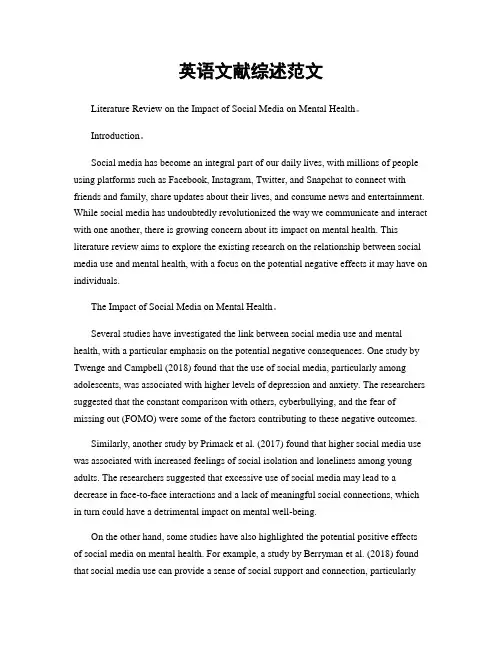
英语文献综述范文Literature Review on the Impact of Social Media on Mental Health。
Introduction。
Social media has become an integral part of our daily lives, with millions of people using platforms such as Facebook, Instagram, Twitter, and Snapchat to connect with friends and family, share updates about their lives, and consume news and entertainment. While social media has undoubtedly revolutionized the way we communicate and interact with one another, there is growing concern about its impact on mental health. This literature review aims to explore the existing research on the relationship between social media use and mental health, with a focus on the potential negative effects it may have on individuals.The Impact of Social Media on Mental Health。
Several studies have investigated the link between social media use and mental health, with a particular emphasis on the potential negative consequences. One study by Twenge and Campbell (2018) found that the use of social media, particularly among adolescents, was associated with higher levels of depression and anxiety. The researchers suggested that the constant comparison with others, cyberbullying, and the fear of missing out (FOMO) were some of the factors contributing to these negative outcomes.Similarly, another study by Primack et al. (2017) found that higher social media use was associated with increased feelings of social isolation and loneliness among young adults. The researchers suggested that excessive use of social media may lead to a decrease in face-to-face interactions and a lack of meaningful social connections, which in turn could have a detrimental impact on mental well-being.On the other hand, some studies have also highlighted the potential positive effects of social media on mental health. For example, a study by Berryman et al. (2018) found that social media use can provide a sense of social support and connection, particularlyfor individuals who may feel socially isolated in their offline lives. The researchers suggested that social media can be a valuable tool for maintaining and strengthening social relationships, which may have a protective effect on mental health.The Role of Social Media in Shaping Body Image and Self-Esteem。
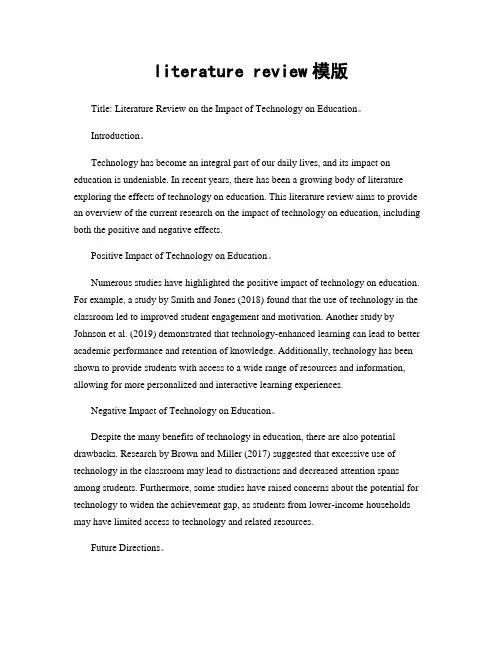
literature review模版Title: Literature Review on the Impact of Technology on Education。
Introduction。
Technology has become an integral part of our daily lives, and its impact on education is undeniable. In recent years, there has been a growing body of literature exploring the effects of technology on education. This literature review aims to provide an overview of the current research on the impact of technology on education, including both the positive and negative effects.Positive Impact of Technology on Education。
Numerous studies have highlighted the positive impact of technology on education. For example, a study by Smith and Jones (2018) found that the use of technology in the classroom led to improved student engagement and motivation. Another study by Johnson et al. (2019) demonstrated that technology-enhanced learning can lead to better academic performance and retention of knowledge. Additionally, technology has been shown to provide students with access to a wide range of resources and information, allowing for more personalized and interactive learning experiences.Negative Impact of Technology on Education。
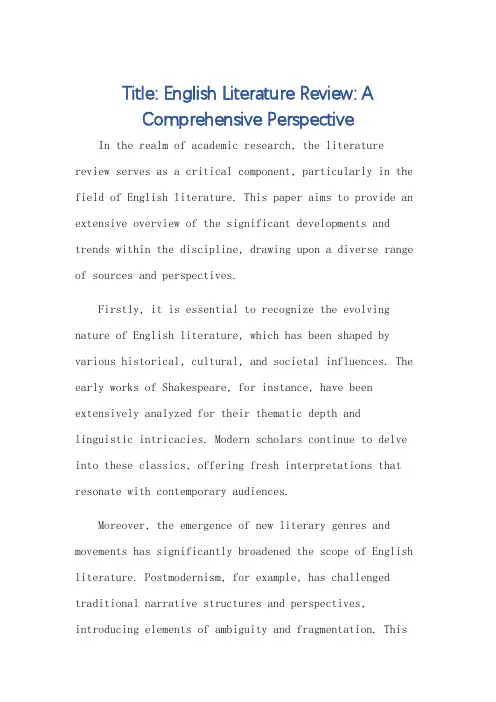
Title: English Literature Review: AComprehensive PerspectiveIn the realm of academic research, the literature review serves as a critical component, particularly in the field of English literature. This paper aims to provide an extensive overview of the significant developments and trends within the discipline, drawing upon a diverse range of sources and perspectives.Firstly, it is essential to recognize the evolving nature of English literature, which has been shaped by various historical, cultural, and societal influences. The early works of Shakespeare, for instance, have been extensively analyzed for their thematic depth andlinguistic intricacies. Modern scholars continue to delve into these classics, offering fresh interpretations that resonate with contemporary audiences.Moreover, the emergence of new literary genres and movements has significantly broadened the scope of English literature. Postmodernism, for example, has challenged traditional narrative structures and perspectives, introducing elements of ambiguity and fragmentation. Thistrend has been explored in numerous studies, highlighting the diverse ways in which authors have responded to and shaped the postmodern era.Furthermore, the intersection of English literature with other disciplines, such as psychology, sociology, and anthropology, has opened up new avenues for research. The exploration of character psychology in literary texts, or the analysis of societal norms and values reflected in literature, are just a few examples of thisinterdisciplinary approach.In terms of methodologies, the literature review has also undergone significant transformations. With the advent of digital technologies and online databases, scholars now have access to vast repositories of information, enabling them to conduct more comprehensive and rigorous reviews. However, the challenge lies in effectively synthesizing and evaluating this vast amount of data.One notable trend in recent years has been the increasing focus on global perspectives in English literature. With the growth of international literary movements and the rise of multiculturalism, scholars arenow more inclined to explore the global dimensions of literary works. This approach not only broadens our understanding of English literature but also promotes cross-cultural understanding and exchange.Moreover, the impact of gender and race on English literature has also been a topic of increasing interest. The examination of how gender roles and racial identities are represented and constructed in literary texts has provided valuable insights into the complex intersections of identity, power, and representation.In conclusion, the literature review in English literature is a dynamic and evolving field that continues to shape our understanding of the discipline. By exploring diverse themes, genres, and methodologies, scholars are able to delve deeper into the rich tapestry of English literature, revealing new meanings and perspectives that resonate with our contemporary world.**英语文献综述:全面视角**在学术研究领域,文献综述是一个至关重要的组成部分,尤其在英语文学领域更是如此。
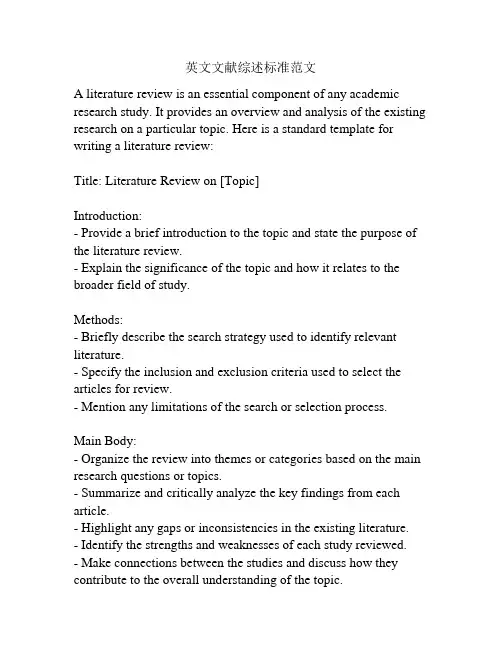
英文文献综述标准范文A literature review is an essential component of any academic research study. It provides an overview and analysis of the existing research on a particular topic. Here is a standard template for writing a literature review:Title: Literature Review on [Topic]Introduction:- Provide a brief introduction to the topic and state the purpose of the literature review.- Explain the significance of the topic and how it relates to the broader field of study.Methods:- Briefly describe the search strategy used to identify relevant literature.- Specify the inclusion and exclusion criteria used to select the articles for review.- Mention any limitations of the search or selection process.Main Body:- Organize the review into themes or categories based on the main research questions or topics.- Summarize and critically analyze the key findings from each article.- Highlight any gaps or inconsistencies in the existing literature.- Identify the strengths and weaknesses of each study reviewed.- Make connections between the studies and discuss how they contribute to the overall understanding of the topic.- Provide a coherent and logical flow of information throughout the review.Conclusion:- Summarize the key findings from the literature review.- Discuss the implications of the findings and address any unanswered research questions.- Suggest areas for further research or propose potential solutions to existing gaps in the literature.References:- List all the references cited in the literature review using the appropriate citation style (e.g., APA, MLA, etc.).- Ensure accuracy and consistency in formatting the references. Note: The length and structure of a literature review may vary depending on the scope and depth of the topic. It is important to adhere to the specific guidelines provided by your academic institution or the journal you intend to submit the review to.。
竭诚为您提供优质文档/双击可除literature,review,模板篇一:打印版literaturereview模板nuclearRadiationanditslong-termhealtheffect(yourtitle)thereisaconstantcontroversyastotheapplicationofnucl earpowerandrisksfromnuclearradiationeversincetheche rnobyldisaster.especiallythereleaseofsubstantialamo untsofradiationintotheatmospherefromjapan’sFukushimadaiichinuclearpowerplantin20xxhastriggere dthewidespreadfearandconcernsoverrisksofradiationle aks,radiationexposure,andtheirimpactonpeople’shealth.thecommonsensicalandintuitiveresponseofthep ublicisthatnuclearradiationismostlikelytocauseacanc erorgeneticdiseases.manyresearchers,however,assured thepublicthatthereisnosubstantialdangerasassumed,andnuclearpowerisnotasfearfulormenacingasitseemstobe. cohen(20xx),blumenthal(20xx)andbai(20xx),forexample ,citednumericalevidenceandresortedtoscientificfacts toillustratethatacertainlevelofnuclearradiationrisk swon’tposerealdangerifhandledproperlywiththecurrenttechn ologyavailableorbyfollowingtheprescribedrules.theyd oadmitthepossibilityofradiationinitiatingcertainkin dsofdiseases,though.onlyexposuretohighdosesofradiat ionorlong-termlowdoseexposurecouldleadtoacutehealth problems(bai20xx).nevertheless,noteveryoneagrees.co rnelio(20xx),ontheotherhand,holdsthatnuclearradiati onismostlikelytothreatenpeople’shealthbycontaminatingmilk,vegetables,andrainwater. theliteratureontherelationshipbetweenradiationandhe althlargelyfocusedonthemanageabilityofnuclearrisksa ndplayeddownthedamagethatnuclearradiationislikelyto cause.theresearchesgenerallytookadetourastowhetherthereis anysolidevidencetobearoutthelong-termhealthimpactof nuclearradiation.thereneedstobemorewell-groundedstudiesonthecorrelationbetweenradiationandhealth,andon thepossiblelong-termhealtheffectsinordertoaddressth econcernsofthegeneralpublic.besides,wealsoneedtoans werquestionslike “whyisthereadisparitybetweenthecommonsensicalfeeli ngofthepublicandtheexplicationofferedbyexpertsconce rningnuclearradiationandhealth”“,arescientistsbiasedandusethefactsandstatisticsto theirfavor”and“istherealong-termnegativehealthimpactifonetakesmo deratedosesofnuclearcontaminatedfoodoveralongperiod”题目小二字体小四如果是400字数刚好,最下面还有一点空间写下名字。
Literature review1. Review of cross-cultural theoriesHofstede’s five dimensions of cultureJust as Hofstede (2001) said “culture is more often a source of conflict than of synergy; cultural differences are a nuisance at best and often a disaster” . For those who work in international business, it is sometimes amazing how different people in other cultures behave. We tend to have a human instinct that deep inside of all people are the same, but they are not in effect. Therefore, understanding cultural differences is often considered a prerequisite for successful international business.According to Hofstede (2001), “each culture must deal with questions that can be resolved according to a series of dimensions, which results in a unique gestalt for each society, depending on the intensity of its tendency towards one or another end of each culture dimension spectrum”.The Five Dimensions areIndividualismUncertainty avoidance indexPower distance indexMasculinityLong-term orientationIndividualism focuses on the degree the society reinforces individual or collective achievement and interpersonal relationships.Uncertainty Avoidance focuses on the level of tolerance for uncertainty and ambiguity within the society.Power Distance focuses on the degree of equality, or inequality, between people in the country's society.Masculinity focuses on the degree the society reinforces, or does not reinforce, the traditional masculine work role model of male achievement, control, and power.Long Term Orientation focuses on the degree the society embraces, or does not embrace long-term devotion to traditional forward thinking values.These five dimensions, taken together, can give important insights for someone wishing to enter a new culture for business, study, or other purposes. Though he made a great contribution to cross-cultural business field, his research still has some limitation. Hofstede’s Five Dimensions Theory has been criticized on the grounds of being too static (Holden, 2001), or being weak in terms of theoretical foundation (Dahl, 2004).Porter and Samovar's cross-cultural communication According to Porter and Samovar (2006), communication has eight ingredients: source, encoding, message, channel, receiver, decoding, receiver response and feedback. Any communication takes places in a certain context and may be hindered by noises in the communication environment, causing communication misunderstanding or even failure. The idea could be illustrated by the following figure:Figure Communication process and stepsEncoding refers to the process of sender putting the message into codes. Decoding refers to the process of the receiver interpreting the message from the sender. Feedback means the reactions of receiver that are sent back to the sender after the receiver's interpretation of the message.Response means the reactions of receiver to the message upon receipt. Noise refers to the disturbances along the communication processes, which may result in unintended message being perceived by the receiver.A complete process of communication can be broken into five steps: (Guffey, 2001)(1) A Sender has an idea(2) The sender encodes the idea in message(3) The Message travels over channel(4) A receiver decodes the message(5) Feedback travels to the senderAdvertising in essence is also a process of communication. The sender here is the company who prepares and issues advertisements. The receiver is expected to be the target consumer group, although it is not always the case, as we will see in the advertising effectiveness analysis. The channel refers to all kinds of media or media mix ranging from flyer, direct mail, and newspaper to billboard, radio or TV etc. Messages about brands, products or services are carefully designed and encoded in advertisements by companies, usually with the professional help of an advertising agency. Favorable responses from the receiver, such as enhanced brand loyalty, purchase behavior are expected by the sender. In order to increase the effectiveness of their advertising, companies will try by any means to get feedback from the customers. However, not every advertisement conveys the right message, nor does every advertising message go to the right audience and most importantly, nor does every receiver respond favorably to the message. A complex of noises, such as bad timing, legal restrictions may hurt the effectiveness of advertising. Moreover, for multinational advertising, the most formidable noise naturally arises from the cultural differences. This is the focus of this thesis.2. Review of international advertising strategydilemmaIn the international marketing literature, the issue of advertising standardization versus localization has ignited a lively and heated debate among academics and practitioners alike for nearly four decades who are still divided on the advisability of using standardized (universal) or localized (individualized) advertising approaches in international campaigns.On the one hand, advertisers who use the standardized approach argue that consumers anywhere in the world have the same basic needs and desires and can therefore be persuaded by universal appeals. On the other hand, advertisers who follow the localized approach assert that consumers differ from country to country and must accordingly be reached by advertising tailored to their respective countries.Unfortunately, research on the relative effectiveness of different degrees of standardization and localization has shown that there are no golden rules that can safely guide marketing decisions. For the sake of further discussion of this issue, it is very necessary to have a review of the long-running debate of international advertising strategies.StandardizationThe standardization advertising approach, sometimes known as the "universal," "global," or "internationalized" approach, is defined as the practice of advertising the same product/service in the same way everywhere, that is, use of the same message, appeal, components of advertisements for different markets in different countries.2.1.1 David L. BrownIt was in 1923 that David L. Brown put forward the idea of standardized advertising. David L. Brown, manager for advertising of Goodyear Tire and Rubber Company, claimed that humanity possessed certain common attributes and so it was not only possible to standardize advertising acrosscountries but also logical. He stated that just as green is green in Buenos Aires as well as in Batavia, just as two and two are four in Cape Town as well as Copenhagen, just as the main purpose of advertising is to sell goods, in Singapore as well as in Sydney or Santiago, so all the primary purposes of advertising are identical in all countries, and all fundamentals of good advertising are essentially the same north and south of the Equator and east and west of Greenwich (Brown, 1923).2.1.2 LevittAmong the proponents of standardization strategy, Levitt is the best known and the most widely cited. His argument for standardization "the earth is flat" is plausible and convenient for his followers to quote to justify their position. Levitt, in his classic article on globalization, suggests that there may be aspects of customer expectations that are universal across products and market segments and therefore should be conveyed in a standardized fashion across cultures (Cervellon & Dube, 2000). According to Levitt, corporations should take advantage of economies of scale in producing and marketing the same product at the same price with the same message all over the world at the same time (Levitt, 1983).2.1.3 Other advocatesOther advocates of the standardization strategy share Levitt's view. De Mooij asserts that just as people show more similarities than differences, so it's also true of advertising techniques that influence people and that the similarities justify advertising across borders (De Mooij, et al, 1991). Link G. L. upholds this school of thought by arguing that more and more markets recognize the need to build a global brand image and identity and that resistance to global advertising should and could be overcome (Link, 1988). Another supporter of global advertising, Peebles recognizes local differences, but contends that there are not insurmountable obstacles to global campaigns (Peebles, 1988).LocalizationThe localization advertising approach, sometimes called "adoption", "customization", "specialization", is referred to as designing specific advertising programs to fit with the unique characteristics of each particular markets.While some proponents of standardization advertising strategy vehemently advocate their theory, many advertising practitioners and researchers argue to the contrary. They contend that while people's basic needs and desires may well be similar, the ways they go about satisfying them vary from country to country (Caillat & Muller, 1996). The "global market" still consists of hundreds of nations, each with their own customs, life styles, economies, and buying habits, price system and on this ground, it's necessary for marketers to take these differences into account when they target foreign markets. Thus, these advertising researchers and practitioners put forward their theory of localized advertising.Proponents of localization pointed out that most blunders in international advertising occurred because advertisers failed to understand foreign cultures. Ricks, Arpan, and Fu (1974) attributed these blunders to blatant rejection of existing customs and innocent insensitivity to the environment. Mueller (1987)compared Japanese advertisements with American advertisements for similar products and observed numerous differences between the two types. Advertisements of each country exhibited some degree of sensitivity to the cultural uniqueness of the particular consuming market. Synodinos, Keown, and Jacobs (1989) investigated advertising practices across 15 countries. They found striking dissimilarities in the creative approach. The researchers attributed such dissimilarities not only to cultural factors but also to production costs and length of time or amount of space of advertisements. Findings of research studies conducted in the last 15 years seem to suggest an increasing trend toward the use of the localized approach.Besides, some scholars and practitioners believe that advertising is moredifficult to standardize than the other elements of the marketing mix. For instance, Boddewyn et al (1986) state that advertising is more resistant to uniformization than products and brands. Because of these characteristics, the visual and verbal parts of advertising are in particular sensitive and use of local language, models and scenery increases the probability for the advertisement to be effective.The controversy over the use of standardized versus localized advertising approaches may continue for decades. While this debate still goes on and no ultimate agreement has been reached, many practitioners keep on failing to get their message across the target consumers, even offending them as a result of not taking care of the local customs, beliefs, values, economic reality, and legal regulations of a new market. The present-day situation of international advertising necessitates further cross-cultural research to demystify the dilemma, for the very reason that international advertising is advertising that reaches across national and cultural boundaries, that is, an attempt to persuade its potential consumers across cultures. To comply with this demand, this paper will primarily investigate the influence of culture on international advertising.Works Cited[1] Boddewyn, J. L., et al. 1986. Standardization in internationalmarketing: Is Ted Levitt in fact right Business Horizon, 29 (6): 69-75.[2] Brown, D. L. 1923. Export advertising. New York: Ronald Press.[3] Caillat, Z., & Muller, B. 1996. Observations: The influence of cultureon American and British advertising: An exploratory comparison of beer advertising. Journal of Advertising Research, 79-88.[4] Cervellon, M., & Dube, L. 2000. Standardization versus culturaladaptation in food advertising: Insights from a two-culture market.International Journal of Advertising, 429-447.[5] Dahl, S. 2004. Intercultural research, the current state of knowledge.Middlesex University Discussion Series.[6] De Mooij, R., et al. 1991. Advertising worldwide. Hertfordshire:Prentice Hall International Ltd.[7] Hofstede, G. 2001. Cultures’ consequences, comparing values,behaviors, institutions, and organizations across nations.Thousand Oaks: Sage Publications.[8] Holden, N. 2002. Cross-cultural management: A knowledge managementapproach. Harlow: Prentice Hall – Financial Times.[9] Levitt, T. 1983. Globalization of Markets, Harvard Business Review,61 (3): 92-102.[10] Link, Q. L. 1988. Global advertising: An update. The Journal ofConsumer Marketing, 5 (2): 69-74.[11] Mueller, D., & Barbara, O. 1987. Reflections of culture: An analysisof Japanese and American advertising appeals. Journal of Advertising Research, 23, 51-59.[12] Peebles, D. M. 1988. Executive insights don't write off globaladvertising: A commentary, International marketing Review, 6, 73-78.[13] Ricks, D., Jeffrey, A., & Marilyn, F. 1974. Pitfalls in advertisingoverseas. Journal of Advertising Research, 5, 47-51.[14] Samovar, L., & Porter, R. 2006. Intercultural communication: A reader.Belmont: Wadsworth, Inc.[15] Synodinos, N., & Jacobs, L. 1989. Transitional advertisingpractices: A survey of leading brand advertisers.Journal of Advertising Research, 7, 43-50.。
文献综述例文英文翻译Literature Review ExampleIntroduction:This literature review explores the concept of mindfulness and its relationship with mental health. Mindfulness is commonly defined as the awareness that arises from paying attention, on purpose, to the present moment, without judgment. In recent years, there has been a surge of interest in mindfulness as a tool for improving mental health. The aim of this review is to provide an overview of the current literature on mindfulness and mental health, and to highlight some of the key findings from this research.Method:To conduct this literature review, a comprehensive search of electronic databases including PubMed, CINAHL, and PsycINFO was undertaken. The search terms included “mindfulness”, “mental health”, “anxiety”, “depression”, “stress”, “psychological distress” and “well-being”. The articles included in this review were limited to those published in peer-reviewed journals between the years 2000 and 2020, in English.Results:The results of this literature review indicate that mindfulness-based interventions are effective in reducing symptoms of anxiety, depression, and psychological distress. Studies have found that mindfulness training can lead to significant improvements in individual well-being, reduced stress, and increased positive affect. One study found that mindfulness meditation was more effective than cognitive-behavioral therapy (CBT) in reducing symptoms of depression and anxiety in individuals with major depressive disorder. Other studies have found that mindfulness-based interventions can improve cognitive functioning, attention, and emotion regulation.Discussion:The findings of this literature review suggest that mindfulness-based interventions hold promise as effective tools for improving mental health. The results indicate that mindfulness training can provide individuals with the tools they need to manage symptoms of anxiety, depression, and psychological distress. Given the effectiveness of mindfulness-based interventions, it appears that these practices have the potential to become an important addition to conventional treatments for mental health disorders.Conclusion:In conclusion, this literature review highlights the importance of mindfulness-based interventions in improving mental health. The results of this review suggest that mindfulness training canlead to significant improvements in individual well-being, reduced stress, and increased positive affect. Further research is needed to elucidate the underlying mechanisms by which mindfulness-based interventions work. Nonetheless, the practical applications of mindfulness practices in treating anxiety, depression, and psychological distress suggest that these interventions have the potential to become an important component of mental health treatments.。
英语文献综述范文English: Conducting a literature review in English requires a comprehensive understanding of the research topic, the ability to analyze and synthesize information, and critical thinking skills to evaluate different studies. The process involves systematically searching for relevant articles, reading and summarizing the key points, analyzing the findings, and identifying gaps in the existing research. A well-written literature review should provide a clear overview of the current state of knowledge on the topic, discuss different perspectives and findings, and propose future research directions. Additionally, it is essential to acknowledge and cite the sources properly to avoid plagiarism and give credit to the original authors for their work.Chinese: 进行英语文献综述需要全面了解研究主题,具备分析和综合信息的能力,以及评估不同研究的批判性思维技能。
literature-review范例教程⽂件l i t e r a t u r e-r e v i e w范例An example of literature reviewOf the many who have looked at the relation between age and performance in universities none has as yet produced a definite answer to the apparently simple question “Do mature students do better or worse than younger students?”Harris (1940) in the United States found evidence to suggest that younger students tended to obtain better degree results. Similar findings have been made in Britain by Malleson(1959), Howell (1962), Barnett and Lewis(1963), McCracken(1969) and Kapur(1972), in Australia by Flecker(1959) and Sanders(1961) , in Canada by Fleming (1959), and in New Zealand by Small(1966). However, most of these studies were based on samples of students who were generally aged between seventeen and twenty-one and the correlation techniques employed meant that the relationship between age and performance really only concerned this narrow age band. As such, the results probably suggest that bright children admitted early to higher education fare better than those whose entry is delayed while they gain the necessary qualifications. This view is supported by Harris (1940) who discovered that the relationship between age and performance disappeared when he controlled for intelligence. Other studies have shown that those who gain the necessary qualifications and then delayed entry for a year or two are more successful than those who enter directly from school (Thomas, Beeby and Oram 1939; Derbyshare Education Committee 1966).Where studies have involved samples containing large numbers of older students the results have indicated that the relationship between age and performance is not a linear one. Philips Cullen(1955), for instance, found that those aged twenty-four and over tended to do better than the eighteen and nineteen age group. Sanders(1961) showed that the university success rate fell until the age of twenty or twenty-one, then from about twenty-two onwards the success rate began to rise again. The problem with these two studies is that many of the older students were returning servicemen. They were often “normal” entrants whose entry to university had been delayed by war and many had undergone some training in science or mathematics while in the armed forces. Also, while Eaton(1980) cites nine American studies which confirm the academic superiority of veterans, there is some contradictory British evidence. Mountford(1957) found that ex-service students who entered Liverpool University between 1947 and 1949 were more likely to have to spend an extra year or more on their courses and more likeyl to fail to complete their course.Some studies have shown that whether mature students fare better or worse than younger students depends upon the subject being studied. Sanders(1963) has indicated that the maturity associated with increasing age and experience seems to be a positive predictor of success for some arts and social science courses. The general finding that older students do better in arts and social science and worse in science and maths issupported by Flecker(1959), Barnett, Holder and Lewis (1968), Fagin(1971)and Sharon(1971).Walker’s (1975) study of mature students at Warwick University represents the best British attempt to unravel the relationship between age and performance, he took 240 mature undergraduates who were admitted to the university between 1965 and 1971 and compared their progress with that of all undergraduates. This gave him a reasonably large sample to work with and the timing meant that the results were not distorted by any “returning servicemen factor”. His methodology showed many other refinements. First, he excluded overseas students. Such students tend to be older than average and also to fare worse academically (Woodley 1979), thus influencing any age/performance relationship. Secondly, he used two measures of performance; the proportion of those leaving without obtaining a degree and the degree results of those taking final examinations. Finally, he weighted the degree class obtained according to its rarity value in each faculty.The following findings achieved statistical significance:(i) In total, mature students obtained better degrees than non-mature students.(ii) In the arts faculty mature students obtained better degrees than non-mature students.(iii) Mature students who did not satisfy the general entrance requirementsobtained better degrees than all other students.(iv) The degree results of mature students age twenty-six to thirty were better than those of all other mature students. Several other differences were noted but they did not achieve statistical significance due to the small numbers involved. The mature student sample only contained thirty-tree women, twenty-six science students and thirty-seven aged over thirty. Theaim of the present study was to extend Walker’s work to all British universities so that these and other relationships could be tested out on a much larger sample of mature students. (Woodley, 1985:152-4)。
The influence of mining exploitation on environment and the solution of the disposal of solid waste residue By the year of 2012, China has 8557 State-owned mining enterprises and over 200 thousands individually owned enterprises. The area of destroyed land in mining area adds up to 29 thousand km^2 and grows at the rate of 2% each year (Liao L-P, Gao.H and Yu X-J, 2012). The mining industry has scored tremendous achievements, but meanwhile it threatens the environment. Some individually owned enterprises lack the awareness of environmental protection and take no preventive measure to lower their cost. Furthermore, out-of-date equipment and poor technology cause huge waste in production, which cause serious environmental pollution.The destruction on land resourcesStrip mining and the piling of tailings and waste residue occupies and destroys large land. In china, the waste-occupied land in mining area adds up to 59 thousand km^2 and the resulting deforestation area adds up to 11 thousand km^2 (Ma X-Q, Huang B-L, 2010). Strip mining can result in the destruction of land surface and Land Subsidence and accelerate the water and soil losses. According to official statistics, by the year of 2011, in the mining area of western China, the Soil erosion area annually increases 20 km^2.The increase of the risk of geological disasterThe construction of mining engineering can significantly change the landform in mining area. Digging to a certain depth will threaten the stability of hillside and easily induce some geological disasters, such as landslip, collapse, debris flow, surface subsidence and even earthquake (Cao F-G, 2007). For example, 4 tons of water will be drained off when 1 ton of coal is mined. The loss of groundwater exerts huge pressure on earthcrust (Gibowicz, 1999). In China, there are nearly 2000 sinkholes and the collapse area adds up to 1150 km^2. Almost 40 of the mining cities in China have Cave-in accident, which threatens the life of mine operators and cause heavy property loss, about 120 million dollars on average each year.The influence on water resourceDeep mining engineering will influence the surface water resources and groundwater resources. Excessive groundwater extraction can cause the drop of water level, some problems on water supply and land subsidence (Auclair AD, 2008). The quality surface water will decrease and the course of river might be changed. In some drought region,the drop of groundwater level can lead to the death of land vegetation (Becker M, 2005). More seriously, huge amounts of industrial water are required tosupport over exploitation in mineral-abundant region and most of the water is drawn from agricultural water, which interferes the agricultural production (Shi X-H, 2009). The loss of biodiversitySoil degradation, environmental pollution, the emission of waste and vegetation clearing are fatal to the biodiversity in mining area. After the loss of biodiversity, some high-resistant species can still inhabit the abandoned land in mining area, but because of the barren soil and the deficiency of microorganism activity, the recovery of ecosystem usually need 10-50 years (Xiao H-L, 2011). The loss of biodiversity in some damaged ecosystems is even irreversible.The solution of the disposal of solid waste residueSolid waste residue is the biggest polluter in mining area and the disposal of it still plagues the government and mining enterprises, so it deserves a separate discussion. The heavy metal ion in solid waste is the most harmful substance. Once contacting water source, these ions will dissolve, making the water corrosive and toxic, and it is very difficult to extract them from the water (FAO, 2004).High technology offers two new methods to solve this problem. One is microorganism technology. The removal of heavy metal ions by microorganism is a new applicable technique. Various types of biomass, including bacteria, fungi, yeast and algae have been evaluated for their heavy metal uptake properties. The most prominent features of biosorption are the use of low cost biomass material and the high efficiency of some biomass to uptake heavy metals in very low concentration (Jose T.Matheickal, 2001).Another one is new corrosion-resisting clay. This kind of clay is toughened, innocuous and environmental-friendly. In the process of disposing the waste residue, the clay will be first made into mud. The clay mud covers the surface of waste residue and after it dries out, the clay will become a waterproof layer and can resist the corrosion of any substance in the soil. Then the waste residue can be sequestered underground safely (Moore, 2005).However, Zhu.J.J has pointed out the possible resistance of the implementation of these methods. There is a lack of related Professional Staff. Disposing the waste residue in high-tech methods will increase the cost of enterprises (Zhu J-J, 2009). What’s more, some individually-owned enterprises are even ignorant of the importance of environmental protection, so they may be completely uninterested in these handling methods .Summary and TipsAlong with the enhancing of the people's awareness of the environment,the environmental management has become indispensable in the development of mining industry. Some relative rules, regulations, and standards show be put on to establish a more rational Working mechanism. If the development condition of the mining industry improves, the mining enterprises will no longer pursue profit at the cost of environment.ReferencesAuclair AD. (2008). A case stury of forest decline in western Canada and the adjacent United States. Water, Air and Soil pollution 53(2): 23-31.Becker M. (2005). Silver fir decline in the V osges mountains: Role of climate and natural culture. Water, Air and Soil Pollution 48: 77-80Cao F-G. (2007). Hunan Geology Science & Technology 21(2): 29-31(in Chinese) FAO. (2004). State of the World’s Chemical Industry, 2009. Journal of Applied Chemistry, 15(10): 195-196Gibowicz. (1999). Magnitude and energy of subterranean shocks in Upper Silesia.The Earth's Interior Structure 32(7): 14-15Jose T.Matheickal. (2001). Removal of Heavy Metal Ion from Wastewater by Using Biosorbents from Marine Algae. Chinese Journal of Chemistry 9(2): 133-136 Liao L-P, Gao H, Yu X-J (2012). Chinese Journal of Applied Ecology 11(2): 61-64 (in Chinese)Ma X-Q, Huang B-L. (2010). A study on self-poisoning effects of Chinese fir plantation. Journal of Nanjing Forestry University 24(1): 12-16Moore.(2005). Changes in structure and composition of modern Industrial raw materials.Modern Industry Management 208(1/3): 223-225Shi X-H. (2009). Rain and its influence on environmental ecosystem. Journal of Inner Mongolia Agricultural University 21(1): 109-114(in Chinese)Xiao H-L. (2011). Increased soil temperature and forest decline. Tropical Subtropical Soil Science 4(4): 246-249(in Chinese)Zhu J-J. (2009). A review on fundamental studies of secondary forest management.Chinese Journal of Applied Ecology 13(12): 168-169。